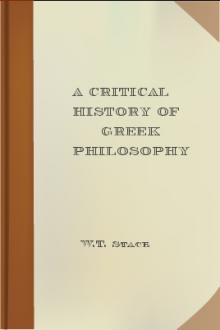A History of Indian Philosophy, Vol. 1 by Surendranath Dasgupta (desktop ebook reader txt) 📕

- Author: Surendranath Dasgupta
- Performer: -
Book online «A History of Indian Philosophy, Vol. 1 by Surendranath Dasgupta (desktop ebook reader txt) 📕». Author Surendranath Dasgupta
__________________________________________________________________
[Footnote 1: There is a story that Kumârila could not understand the meaning of a Sanskrit sentence "Atra tunoktam tatrâpinoktam iti paunaraktam" (hence spoken twice). Tunoktam phonetically admits of two combinations, tu noktam (but not said) and tunâuktam (said by the particle tu) and tatrâpi noktam as tatra api na uktam (not said also there) and tatra apinâ uktam (said there by the particle api). Under the first interpretation the sentence would mean, "Not spoken here, not spoken there, it is thus spoken twice." This puzzled Kumârila, when Prabhâkara taking the second meaning pointed out to him that the meaning was "here it is indicated by tu and there by api, and so it is indicated twice." Kumârila was so pleased that he called his pupil "Guru" (master) at this.]
70
The Vedânta sûtras, also called Uttara Mîmâ@msâ, written by Bâdarâya@na, otherwise known as the Brahma-sûtras, form the original authoritative work of Vedânta. The word Vedânta means "end of the Veda," i.e. the Upani@sads, and the Vedânta sûtras are so called as they are but a summarized statement of the general views of the Upani@sads. This work is divided into four books or adhyâyas and each adhyâya is divided into four pâdas or chapters. The first four sûtras of the work commonly known as Catu@hsûtrî are (1) How to ask about Brahman, (2) From whom proceed birth and decay, (3) This is because from him the Vedas have come forth, (4) This is shown by the harmonious testimony of the Upani@sads. The whole of the first chapter of the second book is devoted to justifying the position of the Vedânta against the attacks of the rival schools. The second chapter of the second book is busy in dealing blows at rival systems. All the other parts of the book are devoted to settling the disputed interpretations of a number of individual Upani@sad texts. The really philosophical portion of the work is thus limited to the first four sûtras and the first and second chapters of the second book. The other portions are like commentaries to the Upani@sads, which however contain many theological views of the system. The first commentary of the Brahma-sûtra was probably written by Baudhâyana, which however is not available now. The earliest commentary that is now found is that of the great S'a@nkara. His interpretations of the Brahma-sûtras together with all the commentaries and other works that follow his views are popularly known as Vedânta philosophy, though this philosophy ought more properly to be called Vis'uddhâdvaitavâda school of Vedânta philosophy (i.e. the Vedânta philosophy of the school of absolute monism). Variant forms of dualistic philosophy as represented by the Vai@s@navas, S'aivas, Râmâyatas, etc., also claim to express the original purport of the Brahma sûtras. We thus find that apostles of dualistic creeds such as Râmânuja, Vallabha, Madhva, S'rîka@n@tha, Baladeva, etc., have written independent commentaries on the Brahma-sûtra to show that the philosophy as elaborated by themselves is the view of the Upani@sads and as summarized in the Brahma-sûtras. These differed largely and often vehemently attacked S'a@nkara's interpretations of the same sûtras. These systems as expounded by them also pass by the name of Vedânta as these are also claimed to be the real interpretations intended by the Vedânta (Upani@sads)
71
and the Vedânta sûtras. Of these the system of Râmânuja has great philosophical importance.
The Nyâya sûtras attributed to Gautama, called also Ak@sapâda, and the Vais'e@sika sûtras attributed to Ka@nâda, called also Ulûka, represent the same system for all practical purposes. They are in later times considered to differ only in a few points of minor importance. So far as the sûtras are concerned the Nyâya sûtras lay particular stress on the cultivation of logic as an art, while the Vais'e@sika sûtras deal mostly with metaphysics and physics. In addition to these six systems, the Tantras had also philosophies of their own, which however may generally be looked upon largely as modifications of the Sâ@mkhya and Vedânta systems, though their own contributions are also noteworthy.
Some fundamental Points of Agreement.
I. The Karma Theory.
It is, however, remarkable that with the exception of the Cârvâka materialists all the other systems agree on some fundamental points of importance. The systems of philosophy in India were not stirred up merely by the speculative demands of the human mind which has a natural inclination for indulging in abstract thought, but by a deep craving after the realization of the religious purpose of life. It is surprising to note that the postulates, aims and conditions for such a realization were found to be identical in all the conflicting systems. Whatever may be their differences of opinion in other matters, so far as the general postulates for the realization of the transcendent state, the summum bonum of life, were concerned, all the systems were practically in thorough agreement. It may be worth while to note some of them at this stage.
First, the theory of Karma and rebirth. All the Indian systems agree in believing that whatever action is done by an individual leaves behind it some sort of potency which has the power to ordain for him joy or sorrow in the future according as it is good or bad. When the fruits of the actions are such that they cannot be enjoyed in the present life or in a human life, the individual has to take another birth as a man or any other being in order to suffer them.
The Vedic belief that the mantras uttered in the correct accent at the sacrifices with the proper observance of all ritualistic
72
details, exactly according to the directions without the slightest error even in the smallest trifle, had something like a magical virtue automatically to produce the desired object immediately or after a lapse of time, was probably the earliest form of the Karma doctrine. It postulates a semi-conscious belief that certain mystical actions can produce at a distant time certain effects without the ordinary process of the instrumentality of visible agents of ordinary cause and effect. When the sacrifice is performed, the action leaves such an unseen magical virtue, called the ad@r@s@ta (the unseen) or the apûrva (new), that by it the desired object will be achieved in a mysterious manner, for the modus operandi of the apûrva is unknown. There is also the notion prevalent in the Sa@mhitâs, as we have already noticed, that he who commits wicked deeds suffers in another world, whereas he who performs good deeds enjoys the highest material pleasures. These were probably associated with the conception of @rta, the inviolable order of things. Thus these are probably the elements which built up the Karma theory which we find pretty well established but not emphasized in the Upani@sads, where it is said that according to good or bad actions men will have good or bad births.
To notice other relevant points in connection with the Karma doctrine as established in the âstika systems we find that it was believed that the unseen (ad@r@s@ta) potency of the action generally required some time before it could be fit for giving the doer the merited punishment or enjoyment. These would often accumulate and prepare the items of suffering and enjoyment for the doer in his next life. Only the fruits of those actions which are extremely wicked or particularly good could be reaped in this life. The nature of the next birth of a man is determined by the nature of pleasurable or painful experiences that have been made ready for him by his maturing actions of this life. If the experiences determined for him by his action are such that they are possible to be realized in the life of a goat, the man will die and be born as a goat. As there is no ultimate beginning in time of this world process, so there is no time at which any person first began his actions or experiences. Man has had an infinite number of past lives of the most varied nature, and the instincts of each kind of life exist dormant in the life of every individual, and thus whenever he has any particular birth as this or that animal or man,
73
the special instincts of that life (technically called vâsanâ) come forth. In accordance with these vâsanâs the person passes through the painful or pleasurable experiences as determined for him by his action. The length of life is also determined by the number and duration of experiences as preordained by the fructifying actions of his past life. When once certain actions become fit for giving certain experiences, these cannot be avoided, but those actions which have not matured are uprooted once for all if the person attains true knowledge as advocated by philosophy. But even such an emancipated (mukta) person has to pass through the pleasurable or painful experiences ordained for him by the actions just ripened for giving their fruits. There are four kinds of actions, white or virtuous (s'ukla), black or wicked (k@r@s@na), white-black or partly virtuous and partly vicious (s'ukla-k@r@s@na) as most of our actions are, neither black nor white (as'uklâk@r@s@na), i.e. those acts of self-renunciation or meditation which are not associated with any desires for the fruit. It is only when a person can so restrain himself as to perform only the last kind of action that he ceases to accumulate any new karma for giving fresh fruits. He has thus only to enjoy the fruits of his previous karmas which have ripened for giving fruits. If in the meantime he attains true knowledge, all his past accumulated actions become destroyed, and as his acts are only of the as'uklâk@r@s@na type no fresh karma for ripening is accumulated, and thus he becomes divested of all karma after enjoying the fruits of the ripened karmas alone.
The Jains think that through the actions of body, speech and mind a kind of subtle matter technically called karma is produced. The passions of a man act like a viscous substance that attracts this karma matter, which thus pours into the soul and sticks to it. The karma matter thus accumulated round the soul during the infinite number of past lives is technically called kârmas'arîra, which encircles the soul as it passes on from birth to birth. This karma matter sticking to the soul gradually ripens and exhausts itself in ordaining the sufferance of pains or the enjoyment of pleasures for the individual. While some karma matter is being expended in this way, other karma matters are accumulating by his activities, and thus keep him in a continuous process of suffering and enjoyment. The karma matter thus accumulated in the soul produces a kind of coloration called les'yâ, such as white, black, etc., which marks the character of the soul. The
74
idea of the s'ukla and k@r@s@na karmas of the Yoga system was probably suggested by the Jaina view. But when a man is free from passions, and acts in strict compliance with the rules of conduct, his actions produce karma which lasts but for a moment and is then annihilated. Every karma that the sage has previously earned has its predestined limits within which it must take effect and be purged away. But when by contemplation and the strict adherence to the five great vows, no new karma is generated, and when all the karmas are exhausted the worldly existence of the person rapidly draws towards its end. Thus in the last stage of contemplation, all karma being annihilated, and all activities having ceased, the soul leaves the body and goes up to the top of the universe, where the liberated souls stay for ever.
Buddhism also contributes some new traits to the karma theory which however being intimately connected with their metaphysics will be treated later on.
2. The Doctrine of Mukti.
Not only do the Indian systems agree as to the cause of the inequalities in the share of sufferings and enjoyments in the case of different persons, and the manner in which the cycle of births and rebirths has been kept going from beginningless time, on the basis of the mysterious connection of one's actions with the happenings of the world, but they also agree in believing that this beginningless chain of karma and its fruits, of births and rebirths, this running on from beginningless time has somewhere its end. This end was not to be attained at some distant time or in some distant kingdom, but was to be sought within us. Karma leads us to this endless cycle, and if we could divest ourselves of all such emotions, ideas or desires as lead us to action we should find within us the actionless self which neither suffers nor enjoys, neither works nor undergoes rebirth. When the





Comments (0)